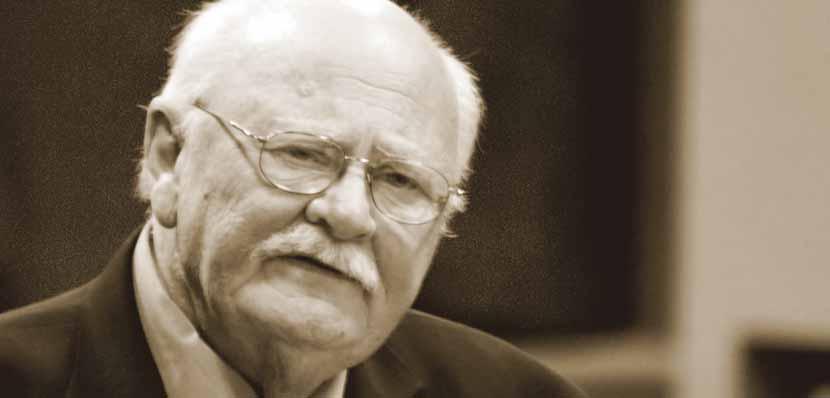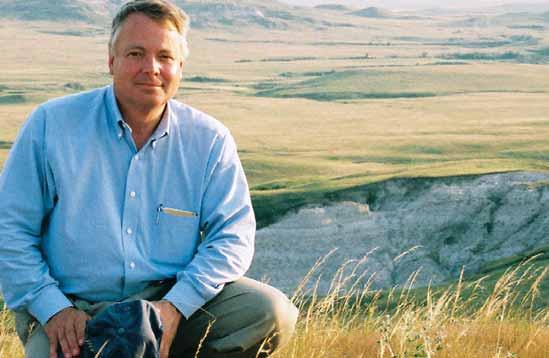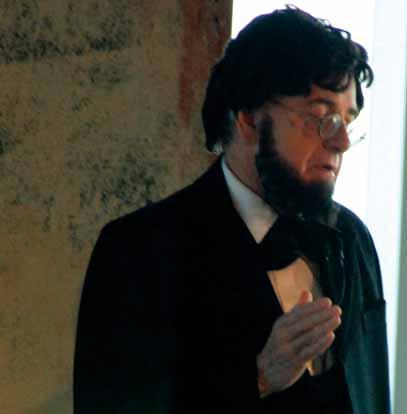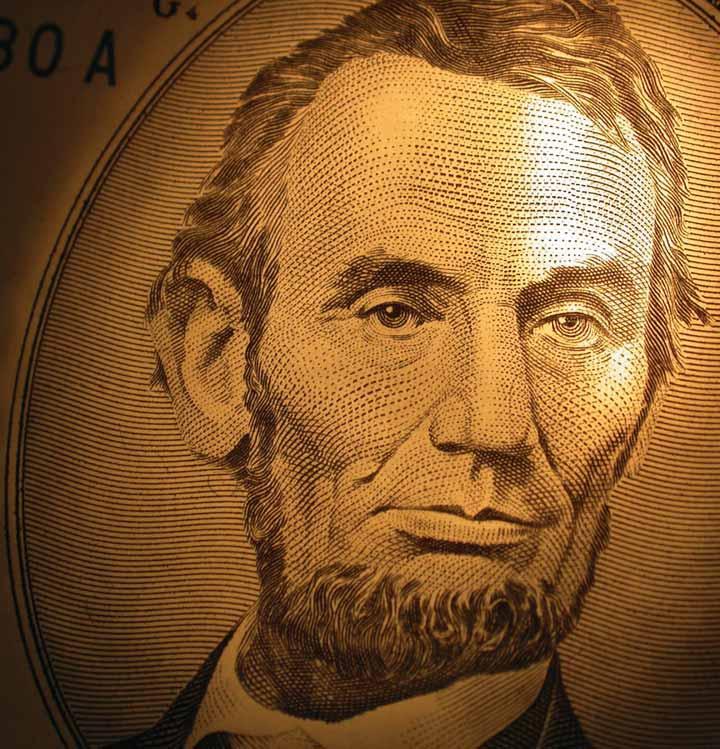
8 minute read
Frederick Douglass, Abraham Lincoln: In Service of a Reconstructed Humanity

Frederick Douglass
By Charles Everett Pace
Advertisement
Charles Everett Pace (top) presents Frederick Douglass, editor, orator, writer, abolitionist, and statesman at the Lincoln Chautauqua. With an M.A. in American studies, history/anthropology from Purdue University, Pace is a long-time participant in Chautauqua programs nationwide. In previous years, he interpreted the African American leader and writer W. E. B. DuBois; York, the man servant of Captain Clark, as well as Booker T. Washington.
In 1860, Frederick Douglass wrote to his abolitionist friend Gerrit Smith that though he hoped for a Republican victory in the upcoming presidential election, he would cast his vote for the Radical Abolitionist candidate because “I cannot support Lincoln.” Clearly, Douglass’s abolitionist’s goals diverged from the goals of the Republican party with Lincoln as its standard bearer. Lincoln felt that slavery was morally wrong. He argued that, while the framers of the U.S. Constitution allowed slavery to continue, it was a compromise move—one that ensured the union of the southern and northern colonies to form the United States of America. But, Lincoln also believed, as he argued the framers believed, that slavery would eventually be disbanded by those same states some time in the future. Nevertheless, because slavery was the law of the land, Lincoln said he would uphold the law.
What he and the Republicans did was to hold slavery within its present locales and restrict its expansion into any newly acquired territories. Thus, the Republicans supported a policy of containment rather than of abolition. Even though Lincoln confessed, “I have always [personally] hated slavery,” this tension between the personal and the political made Lincoln an unacceptable candidate to Douglass and his abolitionist cohorts. Yet, Douglass was also a realist, and because of his own personal and political decisions, had himself incurred severe criticism, even ostracism, from abolitionist friends, including his mentor William Lloyd Garrison.
In 1848, following his move from Lynn, Massachusetts, to Rochester, New York, Douglass, in becoming his “own man,” joined the political abolitionist in a move that placed him at odds with the “moral persuasions” position of the Garrisonians. They championed three main points that Douglass, after numerous conversations with Gerrit Smith, came to doubt and to eventually oppose. The Garrisonian position was: 1) The U.S. Constitution is a pro-slavery document; therefore, they did not engage in party politics, politics that derived its validity from said Constitution; 2) the church was a proslavery institution; and 3) moral persuasion should be the strongest action employed to overthrow the institution of slavery.
Douglass aligned himself with Smith, arguing that the Constitution was actually anti-slavery, and thus it was not only a proper but a wise choice to leverage the power of the political mainstream in his opposition to slavery. He eventually concluded that while southern churches were proslavery and there should be no union with them, this restriction did not apply to northern churches that broke their affiliation with their southern counterparts. Influenced by the ideas of John Brown and outraged by the passage of the Kansas–Nebraska Act, the Fugitive Slave Bill, and The Dred Scott Decision in 1850, Douglass concluded that armed resistance might be necessary to oppose the growing power of the southern planters.
Thus, by the time that he published his second book My Bondage and My Freedom in 1855, Douglass was indeed free, not only from the physical power of slave holders to control his body and labor, but free from Garrison to control his mind. Frederick Douglass assumed the mantle of national leadership in his own right. In restructuring and ‘reconstructing’ his position relative to the Garrisonians, he succeeded in ‘reconstructing’ himself.
Douglass was now in a position to be both a moralist and a politician. He had positioned himself to shift his position in accordance with changes in the world. And, like Lincoln, Douglass understood the power of persuasive words to influence and sometimes even to control public opinion, as well as to advance one’s moral and political agenda. Thus when it became clear that the “war of the rebellion” was not a “skirmish,” a fight that would be easily and effectively put down by Northern troops, both Douglass and Lincoln escalated their efforts in personal and political reconstruction.
With the realization that the country was in the midst of a full-scale civil war, Douglass emerged as an ardent supporter of Lincoln, even though he remained critical of his policy of only opposing the rebelling slave holders, rather than warring with the real enemy, slavery itself, which was the basis of the slave holders’ power. As a result, he called for a war to free the slaves, as well as a war to save the union. He also called for the even more radical position of arming black men to fight in the Union military. Douglass felt that this position would have the multiplier effect of joining slavery’s moral opposition with the political agenda of saving the union.
This was, of course, precisely the position that Lincoln, by late 1862, himself had reached. He declared in his Emancipation Proclamation that as of January 1, 1863, all slaves in the rebellious states were now and “forever free.” Lincoln also adopted the radical position, long advocated by Douglass, that black military might was a resource that must be tapped, and he too became an abolitionist.
became a major recruiter of the Massachusetts 54th and 55th Regiments. His oldest sons were his first two recruits. Also, in a meeting with Secretary of War Edwin Stanton, self-made man, was a man of the masses. He was one order. The result of this personal/political reconstruction
Douglass agreed that upon receipt of his promised commission in the officer corps, he would join General Lorenzo Thomas in the Mississippi Valley. When his commission was not issued, he refused to join the army but did continue to recruit.
In the end, it was this juxtaposition of the abolitionist War to Save the Union that set Douglass up to become not only a challenger, but also a champion of Lincoln as a symbol of reconstructionist ideals. It set Douglass on the road to becoming a staunch and life-long Republican operative.
After the war, Douglass worked to aid Lincoln’s Reconstruction aims. After five years of combat with more than 600,000 dead, northern and southern whites were Reflecting on this fact, Douglass went on: “When
much more willing to unify with each other than either side was to unify with blacks, whom they regarded as the primary beneficiaries of the war. Many, if not most, whites questioned not only the desirability but also the very possibility of union, in terms of human equality, between blacks and whites.
Around this issue, Douglass once again merged the personal with the political by leveraging the memory of his three war-time meetings with Lincoln as a demonstration of the reality of black and white social relations based on the recognition of human equality. In so doing, he hoped humanity of blacks is questioned even further, during
that their personal and political relationship would serve as the living symbol of a racially unified America. It could serve as a model for the potential, reconstructed, equal relationship between blacks and whites in the nation as a whole.
In later years, Douglass made sure that his reception by the president got maximum contemporary and historical coverage, the most prominent being his speech, “Oration by Frederick Douglass, delivered on the occasion of the Abraham Lincoln, in Lincoln Park, Washington, D.C., April 14, 1876.”
In this address, Douglass portrays how Lincoln, during the course of his administration from 1860 to 1863, in fact, reconstructed himself—in both his racial consciousness, as well as in his relationship to blacks. At the beginning of his administration, Lincoln, the of them in belief and behavior. But in order to save the union, Lincoln was forced into a confrontation with his own psyche and concluded that for our national salvation (and perhaps his own), he would have to, and he did, reconstruct his ideas, policies and behavior to meet the realities of a changing and new world/national is that former slaves were now citizens and the “divided house” was now unified.
Thus Lincoln serves as a model of the mental and behavioral transition that others, the masses, people like him, must and can make with the right type of leadership. And, because of this example, black people are in his debt and paid homage to him symbolically through the erection of the Lincoln monuments. therefore, it shall be asked what we have to do with the memory of Abraham Lincoln, or what Abraham Lincoln had to do with us, the answer is ready, full, and complete.
Through this oration, he places the black race squarely within the actions of a civilized people. He links the monument’s dedication with the reconstructionist vision of the assassinated president. Douglass closes with a comforting admonition, noting that when the unveiling of the Freedmen’s Monument, in memory of
those times “…we may point to the monument we have this day erected to the memory of Abraham Lincoln” and proclaim their right to sit at the seat of the highest reaches of a common humanity.
FOR FURTHER REFLECTION:
David W. Blight. Frederick Douglass’ Civil War: Keeping the Faith in Jubilee. Louisiana State University Press, 1989.
Dudley Taylor Cornish. The Sable Arm: Black Troops in the Union Army, 1861-1865. University of Kansas Press, 1987.
Frederick Douglass. The Life and Times of Frederick Douglass (1892); rep. Dover, 2003.
Waldo E. Martin. The Mind of Frederick Douglass. University of North Carolina Press, 1984.
William S. McFeely. Frederick Douglass. W. W. Norton, 1991.
James Oakes. The Radical and the Republican: Frederick Douglass, Abraham Lincoln, and the Triumph of Antislavery Politics. W. W. Norton & Company, 2007.









